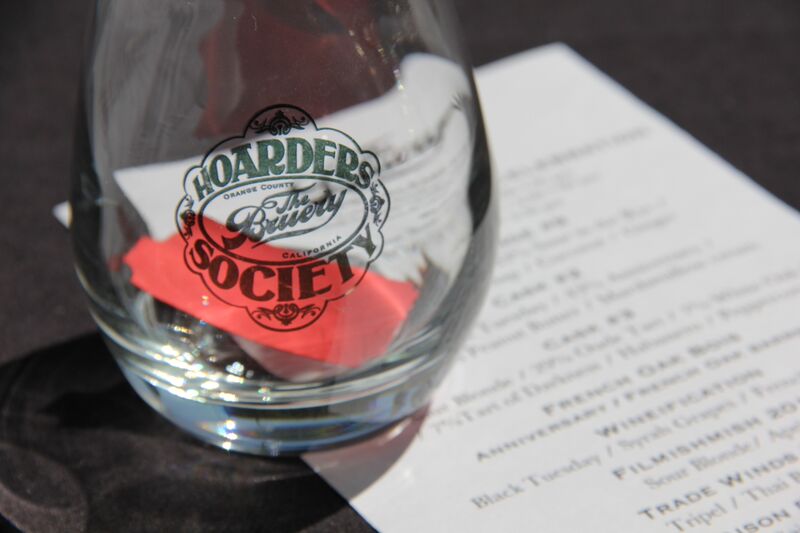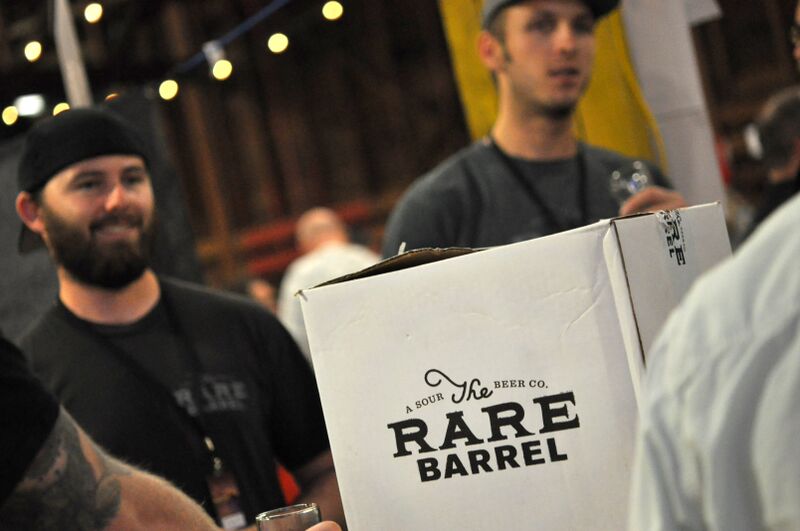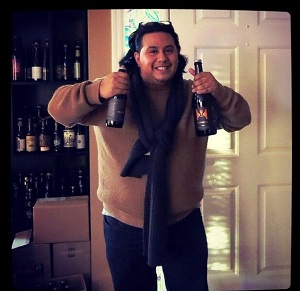Members Only
Brewery Patrons Pay for the Privilege of Scarce Bottles

The Bruery offers limited bottles through its Preservation Society, Reserve Society and Hoarders Society. (Photo courtesy The Bruery)
Beer is big business in Bend, OR. Its behemoth, Deschutes Brewery, is where Paul Arney worked his way up to assistant brewmaster before quitting in 2011 to launch his passion project, dubbed the Ale Apothecary. Compared with Deschutes’ 335,000 barrels produced in 2014, Ale Apothecary sold just 75 barrels’ worth of beer last year.
However small the production, throngs of beer lovers make the trek to the Ale Apothecary each year, in the woods outside the city, where outside the garage-based brewery is a hand-carved, Finnish-style kuurna (think of it as a canoe meets lauter tun) used to make Sahati Ale, a limited-production, spruce and Cascade hop-forward beer. The best way to get your hands on it is to join the brewery’s Ale Club for $300 a year.
Even doubling the membership cap this year means merely 200 lucky souls are afforded the privilege of paying in advance for Ale Apothecary’s ultra-limited releases. And until such day that Arney opens his tasting room in town, members primarily need to drive up the mountain road to retrieve their allotment.
Some beers get fussed over. Some are downright coveted. Rarely are such specimens found perched on the shelf of your local grocer or even in the chiller at your nearest bottle shop. It wasn’t terribly long ago that interesting beer was hard to find on supermarket shelves. Now, the more rare the beer, the faster it disappears from said real estate. Increasingly, smaller breweries are turning to pricey memberships to get their most artful expressions straight to the mouths of devout fans.
The Evolution of Beer Clubs
Beer clubs have come a long way, and sometimes the beer itself has, too. In 1994, with the help of iconic beer scribe and the original “Beer Hunter,” Michael Jackson, The Beer of the Month Club became reality, and adventurous beer drinkers across the United States could get heretofore exotic beers delivered to their doorsteps. Twenty-one years later, the BOTM club still ships in the contiguous United States (except Utah). A decade ago it added The Rare Beer Club to its portfolio. An early example of what Rare Beer Clubbers received was Cuvee de Tomme—then by Pizza Port but now The Lost Abbey—a cross between a Flanders brown and a kriek that Jackson described as “arguably more complex than Rodenbach.”
To join, all interested parties had to do was fill out a form and hand over payment. No hoops, just beer in the mail. Then things became complicated. Recall the famous words of Groucho Marx: “I don’t want to belong to any club that would accept me as one of its members.” There are many who have joined Groucho’s ranks, those who were never invited to be a member of The Bruery’s Hoarders Society.

Members of The Bruery’s Hoarders Society pay an annual cost of $700 to receive scarce bottles of beer. (Photo courtesy The Bruery)
The club, run by the Placentia, CA-based brewery, comes at an annual cost of $700 and is The Bruery’s invitation-only tier of its three societies. The Bruery does not disclose the particularities or algorithm used to determine who receives invites, but the number of hoarders is in the low hundreds; the figure climbs to a few thousand among all tiers. Membership in this club—and in most cases at other breweries—includes more than just beer; it often entails special glassware, a members-only shirt or hoodie (why have none included a Members Only brand jacket?), exclusive party invites, discounted beer and food, and the prerogative to purchase extras of particular releases. But some custom bottle opener or growler ain’t the selling point. It’s the super-scarce bottles. For Bruery Society members, that’s often a variation of its profoundly popular imperial stout—Black Tuesday—perhaps aged in Madeira barrels or on hazelnuts and renamed Grey Monday.
The Hoarders Society is essentially—according to The Bruery’s Ben Weiss—“Pretty much a double Reserve Society.” In this era, apparently even beer membership can be imperialized. Reserve Society, which The Bruery launched in 2009, is a comparative bargain at $295. Hoarders get more of everything—beers, discounts, invitations. In the opposite direction, there’s the entry-level Preservation Society, which is paid (and potentially renewed) on a quarterly basis. For just under $60 per quarter, members are entitled to three distinct 750-mL bottles.

Jay Goodwin and Alex Wallash of The Rare Barrel in Berkeley, Calif.
Up in Northern California at The Rare Barrel—co-founded by The Bruery’s former brewer and head of barrel-aging, Jay Goodwin—sour heads joyfully pay $300 to join Ambassadors of Sour and receive two bottles each of five beers such as Ensorcelled (dark sour with raspberries), which earned a gold medal at the 2014 World Beer Cup. “It could’ve been a bigger money maker,” says co-founder Alex Wallash, “but we gave them to members.” Two release cycles later, they did it again with Cosmic Dust (golden sour with hibiscus) after winning gold, this time at the Great American Beer Festival. Much of The Rare Barrel’s Ambassadors of Sour “is modeled after The Bruery’s,” says Wallash. “By paying upfront they’re saying, ‘We trust you to deliver a great experience.’”
That sentiment is echoed by Rob Burns at Night Shift Brewing in Everett, MA, which forwent crowd sourcing via Kickstarter in favor of the barrel society model. “What members are buying into is a collection of works, a sampling of our brewing philosophy, a journey through our brewing knowledge.” Fans can buy in as Aficionados ($150 for seven bottles), Connoisseurs ($250 and get double), or become Cellarmasters for $450 (quadrupling up on beers like a wheat wine aged in rum and brandy barrels).
For all the above, members or their “trustees” must pick up their hauls at the brewery. Some clubs allow members to pay extra for shipping, but always only within their home state.
That’s not an issue for Mike Ohgg, who accepted his invitation to the Bruery’s Hoarders Society and visits the tap room at least weekly to pick up bottles and take advantage of the 20 percent discount his member card authorizes. Ohgg, 24, works at a mortgage company and drives a BMW. He also renewed his membership at Brew Rebellion, another Southern California brewery, which costs $250 to join. When asked if he ever plans to relinquish his Hoarders status, he says, “Unless I can’t afford it.”

Beer Collector Os Cruz (Photo courtesy Os Cruz)
Fellow rare beer hunter Os Cruz, 35, spends nearly a combined $600 for his memberships in Sante Adairius Rustic Ales’ SARA’s Cellar and De Garde’s Keepers Society. He affords his habit by working in IT in “upper-level management” within the health-care industry. As he recalled, “the first beer that I could not land at a store was Founders [Canadian Breakfast Stout]. I think that beer single-handedly attracted people that weren’t even beer lovers. That’s when this ultra-hyped, super-limited bottle hunting became almost a pop subculture.”
Pennsylvania’s Tired Hands Brewing Co. runs the Believer’s Club with three price points. Tier One is $500, which secures members $500 gift cards used to reserve releases (as well as 10 percent off all purchases put on the card) within a year. Tier Two costs $1,000. There’s a third tier good for three years and 30 percent discounts that comes with a gift card worth the price of its $2,000 club fee.
A common theme among breweries offering memberships, besides including branded Teku glasses—the “it” glassware—is that they specialize in wild ales or other barrel-aged, extreme offerings. Another exciting element is that they’re cropping up in towns not synonymous with beer destinations. Examples include Burley Oak Brewing Co.’s Barrel-aged Rations Club ($160 for six bottles) in Berlin, MD; Three Brothers Brewing’s Horizon Society ($100 for four bottles) in Harrisonburg, VA, and Lansing, IL’s Transient Artisan Ales’ Reserve Program ($185 for six bottles per six-month membership).
The primary reason brewery clubs don’t send beer to out-of-state members is because mailing beer via the United States Postal Service (USPS) violates federal law and the private carriers FedEx and United Parcel Service (UPS) generally don’t ship beer (but are A-OK with wine). Having said that, U.S. Sen. Tom Carper, (D-Delaware), is attempting to legalize mailing beer in order to help save the USPS. That would be a boon to brewery clubs.
The Saga of Saints and Sinners
Back to that Cuvee de Tomme. The Lost Abbey ran its Saints and Sinners clubs from 2006 to 2010, but obviously not without its challenges.
“Beer was starting to turn the corner and become considered high-end,” says Tomme Arthur, the director of brewing operations. Saints and Sinners didn’t have any other brewery clubs to model itself after so it emulated the winery memberships, at least in part. “We took advantage of that wine world mentality and invited (members) into the brewery at a high level. We made some incredible beers available to incredible consumers who prized them.”
Yet brewery clubs are generally annual memberships, whereas many wineries let people jump in or out each month. An exception that Arthur referenced is cult winery Screaming Eagle Vineyards, which produces some 500 cases a year, yet its storied waiting list is 5,000 oenophiles long. “If we’d put a Duck Duck Gueuze into that club level,” said Arthur, referring to The Lost Abbey’s vaunted beer analogous to a Screaming Eagle Cabernet, “[members] would want more than the 300 cases we make.” You can see how creating an elite membership becomes a tightrope walk. “They want the most exclusive things and at the highest level.”
The upside is that members turn into brand ambassadors. There’s a reason most of the current crop of brewery societies include exclusive garb; it’s not unlike sports fans donning their favorite team’s jersey. They become the figurative sixth/twelfth man.
The chief challenge, according to Arthur, became managing members’ expectations and deliverables. “We tell you [a certain beer will be available] in January, but it’s March before it’s done. A barrel-aged beer is on its own schedule. So you’re constantly chasing that schedule [while members keep asking], ‘Why can’t you meet the deadlines?’ It’s our fault, but it was delayed for the best beer possible. We were missing more than we were succeeding.”
The Lost Abbey may one day revive Saints and Sinners “if,” says Arthur, “we can head things off at the pass.” Selling beer DTC—manufacturing speak for direct to consumer—may not be a nice-to-have, it could become a need. “If we’re becoming a nation of 9,000 breweries, direct to consumer needs to become legal at least for the small and uber rare (brands). Lots would like to be in that arena. There are already 9,000 wineries … so the wine lobby has done a great job. We don’t have that same access to market.” The problem remains, laments Arthur, “I personally don’t know anyone at a brewery level doing it 100 percent how they think they should.”
Crooked Stave’s Chad Yakobson agrees. The Denver brewery briefly operated a club, and Cruz, the collector, was among the many who shelled out $300 a year for 10 bottles plus the accouterments. Cruz, of New Jersey, says his rarefied bottle of Persica—a barrel-aged wild ale with peaches—had first been disappointing to members for its overt, buttery diacetyl but “is drinking beautifully now.”
But as Yakobson puts it, “the membership model didn’t fit with our goals. … It comes with a lot of headaches.”
Liquid Addiction
One such headache, the influx of cash, doesn’t sound like it should be remotely problematic. But liquid (as in bucks, not beers) is a funny thing. “Taking money up front and spending it is called debt, and debt of that kind is the most risky,” says Yakobson. “It’s not a healthy means of capitalizing.”
It’s what Arthur refers to as “liquid crack.” The temptation of massive cash infusions for new fermenters or handsome racks full of barrels is hard to resist.
Adds Yakobson: “I’m just not comfortable with the pressure it put on our brewery. I’d rather make creative beers because they come to me, not because I’m forced to, which is how the membership made me feel after a few years.”
Not every brewery offers a club to bankroll its own barrel program. The new Spellbound Brewing Co. in Mount Holly, NJ, really just wanted a tasting room.
“We were thinking of doing a Kickstarter campaign,” says John Companick, who founded the brewery with Michael Oliver and Scott Reading. “And since people asked if we’d do a club or something special [we realized], yes, it would not hurt to have a couple more dollars.” Kickstarters, he added, “feel desperate,” and it’s not like the overall brewery hinged on the funds.
Now 150 friends and family have coughed up $125 each to join the Founders Club, and that club will never grow. Bottled beers such as the first one coming up, an oatmeal raisin cookie ale aged in 20-year-old rum barrels, are not included in the price, but members get first crack. Then again, the beers they pour at Founders private events will never be sipped by nonfounders, and those in the inner circle are very happy with the arrangement.
An hour’s drive east of Companick’s brewery, near Lancaster, PA, Spring House Brewing offers paid club access that has generated much dissatisfied buzz online.
“The issue with Spring House that is most aggravating,” writes one user by the name of Stakem reached via the Web forum TalkBeer.com, “is their lack of communication and lack of creating a quality product worth the prices they are charging. The beers released thus far all seemingly have fundamental flaws that should have been learned or ironed out well before charging a premium price for an exclusive club. They claimed it was a six-month membership, but all said and done it’s a one and a half year experience. Some breweries, even if they produce quality normal offerings, might not have the slightest clue what they are doing when it comes to barrel aging beer. Joining an unproven project/membership like this is not a gamble I will play in the future.”
The result is that even starting such memberships is a risk for the breweries. Yes, they “give us a way to connect to our customers [who] take ownership in a way,” says The Rare Barrel’s Wallash, but the one thing breweries have learned—or will learn—is that “you need to make sure you have the infrastructure for it.”
The Rare Barrel has one full-time coordinator. Ale Apothecary has signed a lease for a tasting room in Bend and will hire a manager. The Bruery has six staffers dedicated to its Society Fulfillment Center to handle
everything from communicating with members to shipping out their allotment (because sometimes that is its own can of worms). “Some have a sense of entitlement,” says Weiss. “We try to give them the best, and they deserve that.” He suggests the two tools to achieve a successful club are “manpower and a lot of beer ideas.”
It’s that second item that causes many to enroll in the first place. Beer geeks may be quick to join untested clubs for the allure of acquiring prized bottles—“whales” and “trade bait” in the vernacular. Across the board, brewers enjoy this aspect. Says Night Shift’s Burns, “It has really helped our small brewery grow and spread the word nationally. … It’s also cool to see what trade value our beers have. It’s always humbling to see our beers being valued against so many other great breweries.” Added Ale Apothecary’s Arney, “Unlike wine, where people tend to hoard, the beer consumer takes great pride in sharing.”
Counters Cruz, “I don’t like the idea of hoarding, but who am I to say someone shouldn’t have 10 Black Tuesdays?”
Not every such restricted release turns into a Black Tuesday even if, conceptually, that’s what both producers and consumers hope the select liberated libations become. Memberships are ultimately for the people paying high prices. Concludes Cruz, “There are some other breweries who I think jump on the idea without understanding it. You have breweries that don’t necessarily put out many beers that sell out or are hard to get. That sounds pretty snobbish, but the truth is, if it’s not a beer or brewery that people want, then paying up front or a premium makes little sense.”
Brian Yaeger
Brian Yaeger is the author of Oregon Breweries and Red, White, and Brew: An American Beer Odyssey. He begrudgingly tweets at @yaeger.

I’m not impressed and have almost no interest in whole cult beer hype. The measure of a good brewery is the quality of its regular (or seasonal) beers, the ones available to the general public. If you want to brew a one-off for the taproom or festivals, that’s one thing, but these so-called “limited edition”/membership beers for hoarding/trade-bait have no serious appeal to people who genuinely respect beer. Beer is supposed to be the peoples’ beverage, a social drink; this contrived elitism is profoundly anti-social.
Having been in both the wine and beer worlds, the supposed “beer elitists” may be some of the most generous people I’ve ever had the pleasure of meeting. While I agree that a brewery should have good beer across the board, there’s nothing wrong with offering special/rare releases to those who want to pay for it or put in the effort to acquire them.
edit… missing word in first line. “…no interest in **the** whole cult beer hype.”
Excellent look at the club phenomena. Might be worth a follow-up article looking at those breweries with highly soft after beers that don’t do clubs; there are definite side-effects to that decision as well.